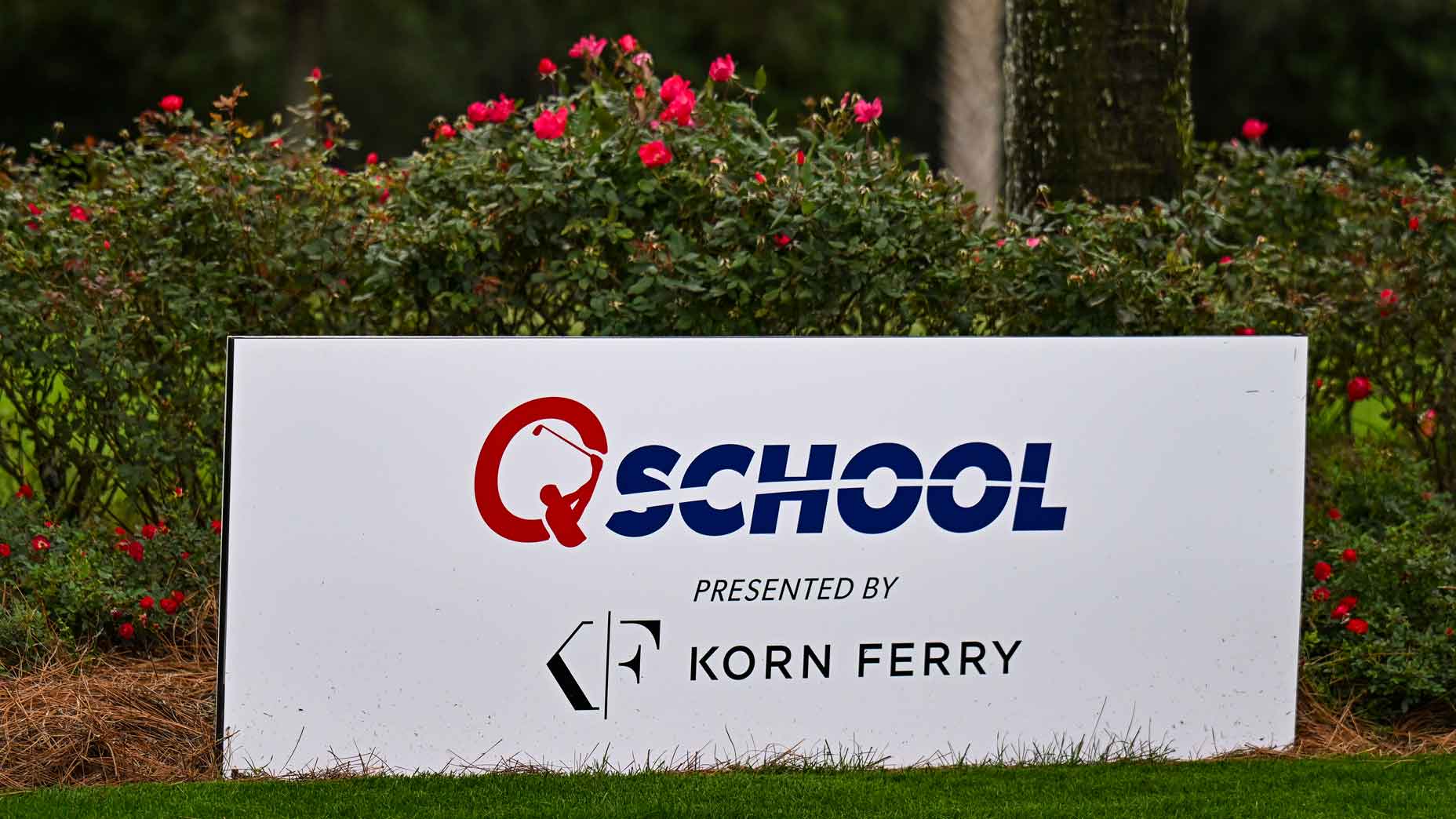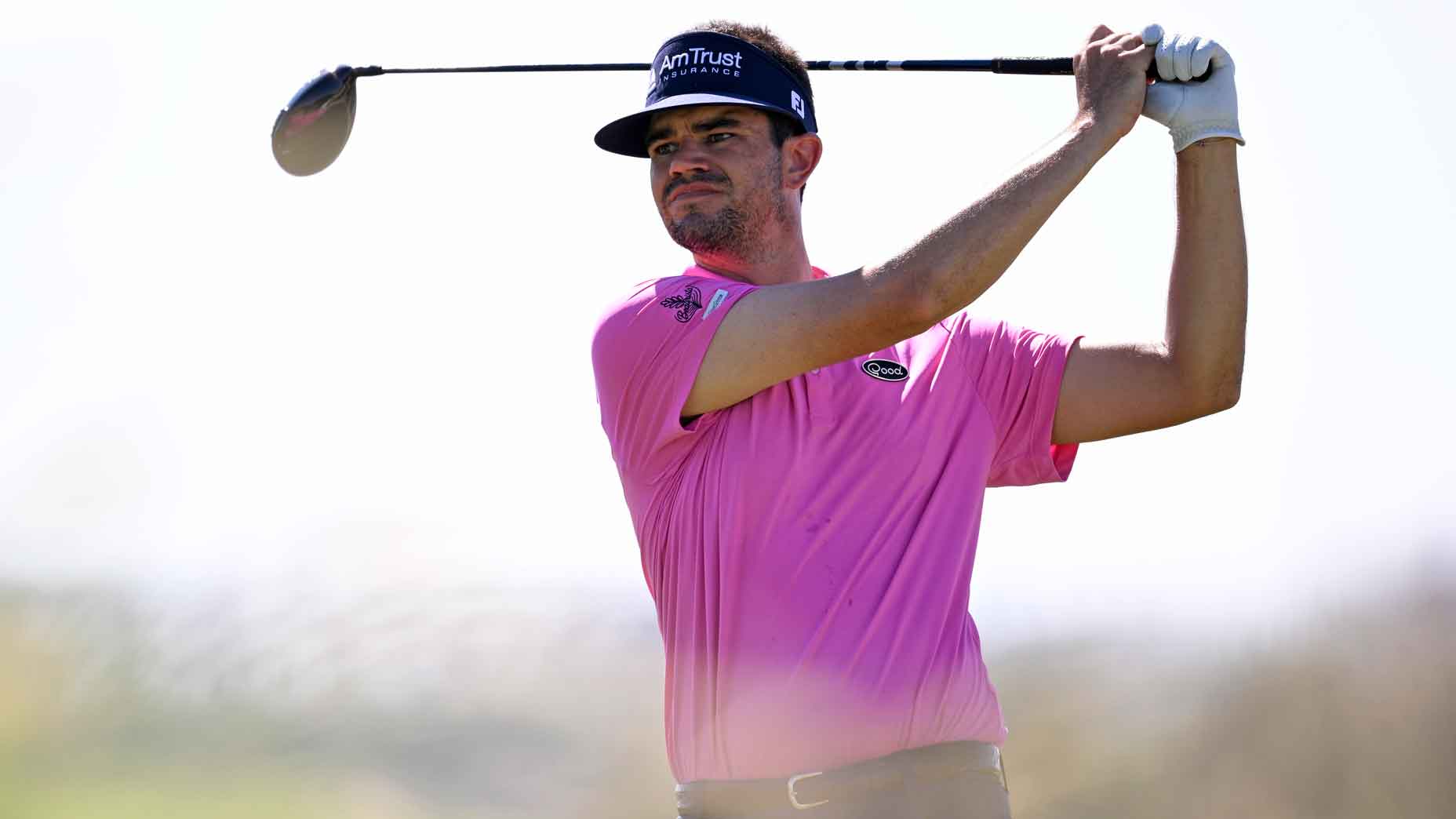Relive all 14 major championship victories of Tiger Woods’ career with our rankings, including detailed accounts of each win.
No. 14 — The 2006 PGA Championship
Tiger posted 21 birdies and only three bogeys in 72 holes and won fairly easily during a birdie-fest that tarnished Medinah’s reputation as a major-worthy site. There was potential for an exciting finish since Woods began the final round tied with Luke Donald, but Donald melted with 74 and Woods shot 68 and easily won by three over former PGA champ Shaun Micheel. — Gary Van Sickle
No. 13 — The 2007 PGA Championship
Tiger avoided a major-season shutout by outdueling Ernie Els and Woody Austin in a sloppy final round at Southern Hills. The pursuers had closed to within a shot when Woods slammed the door with a clutch 7-iron shot and a 15-foot birdie putt at the 15th hole. Southern Hills was supposed to be a Tiger-killer course with its many doglegged fairways that he had played so poorly in the ’01 U.S. Open, but he proved the experts wrong.— Gary Van Sickle
No. 12 — The 2005 Masters
With apologies to Gene Sarazen, Tiger’s chip-in on the 16th hole in the final round is now the most famous shot in golf history thanks to instant replay. It is no less fantastic now as that ball rolls backwards towards the cup, teeters on the edge and finally drops. Hollywood couldn’t have done it better. The fact that Woods bogeyed the next two holes, and then needed two more holes to dispatch the gritty DiMarco only added to the drama.— Gary Van Sickle
No. 11 — The 2005 British Open
This was not the robot Tiger of 2000. This was Tiger in the midst of a reboot, fine-tuning yet another swing change.
Still, he played like an android assassin, laying waste to a championship field.
Attacking the Old Course with mechanical precision, Woods opened with a steely 66 on Thursday, then backed it up with rounds of 66, 67 and 71. He led wire to wire and was never really threatened. If there were glitches in the system, they didn’t show.
For anyone in search of human subplots, the week was sweetly scripted. Jack Nicklaus, who’d claimed two of his majors at St. Andrews, opted to make this his Open swan song. He missed the cut, and bid farewell on Friday from the Swilcan Bridge, clearing the weekend stage for his successor, who had claimed the Claret Jug at the Old Course in 2000 and with this repeat completed a second career Grand Slam — at least two titles at each of the four majors.
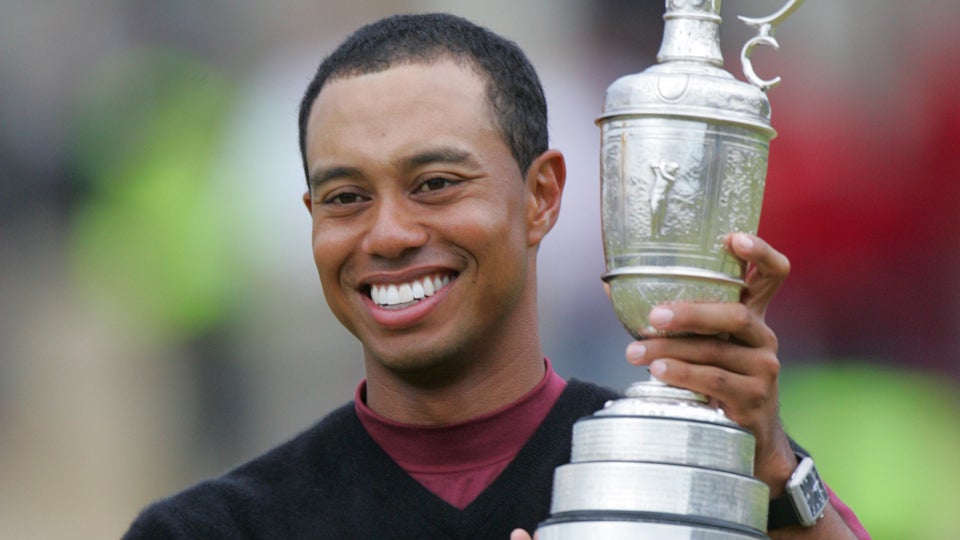
With emotions riding high around him, Woods went about his cold-eyed work, navigating breezes and quirky bounces and completing all four rounds with just a single three-putt. (Even that was on a short par 4 he’d driven, so he walked off the green without losing a stroke.)
A few players came within radar distance, including Sergio Garcia, Jose Maria Olazabal and Retief Goosen. But it was Colin Montgomerie who finished closest, five strokes off Tiger’s steady pace. You had to feel for Monty, falling short once more to Iron Byron. It had happened to him famously at the ’97 Masters, when Tiger blew away the competition at Augusta. That week, in Georgia, after being paired with Tiger in the third round, Monty had rung a note of resignation that would have applied nicely at St. Andrews, too. “All I have to say is one brief comment. There is no chance. We’re all human beings here.”
Well, nearly all of them, anyway.— Josh Sens
No. 10 – The 2002 Masters
By age 26, been-there-done-that moments were piling up for Tiger Woods. One feat he hadn’t accomplished, however, was repeating as Masters champ. Only two players had ever gone back-to-back at Augusta, Jack Nicklaus in 1965-66 and Nick Faldo in 1989-90. On April 14, 2002 Woods ticked another box by defending the title he had captured in 2001. It had all the suspense of a church bake sale.
During a rainy, mud-stained event that forced Woods to play 26 holes on Saturday, on a golf course that had been “Tiger-proofed” (again), with trees planted and nine holes lengthened, no one had any answers for golf’s dominant Number 1.

By Saturday night, a dream leaderboard had emerged, with Woods and 2001 U.S. Open winner Retief Goosen (World No. 4) tied at the top at 11-under-par 205, followed by four others ranked in the top 7, Vijay Singh (7th) , Ernie Els (3rd), Sergio Garcia (5th) and Phil Mickelson (2nd). By Sunday night, it was a dream deferred for everybody except Woods.
On a dull final round with little movement at the top, Woods dropped an enormous wet blanket on the field. His 71 was sufficient to down Goosen by three and Mickelson by four, but it may as well have been 13 and 14, so complete was his beat-down. “You just know Tiger is not going to make any big mistakes,” said Goosen, whose three-putt bogey at the first hole set the stage for failure, as Woods was opening with par-birdie-birdie.
Added a dazed Mickelson, “When other guys are up there, you know that if you can just stay around there, there’s a good chance they might come back two or three shots. But Tiger doesn’t seem to ever do that.” After Woods chipped in for birdie from behind the green at the par-3 6th, everybody was playing for second — yet again.— Joe Passov
No. 9 – The 2000 British Open
In preparation for this millennial Open, the R&A had deepened and steepened the fabled bunkers at the Old Course, which doesn’t mean that they’d actually Tiger-proofed the track.
A little more than a month after blowing away the field by 15 strokes at the U.S. Open at Pebble Beach, Woods winged into St. Andrews and stripped the home of golf down to its studs.
He went around on Thursday in 67, then tacked on scores of 66, 67 and 69 en route to a 19-under tournament total that was eight strokes clear of the closest competition, runner-ups Thomas Bjorn and Ernie Els.

By claiming the Claret Jug, Woods, then 24, became the youngest player ever to complete the career Grand Slam, snatching the honor from Jack Nicklaus, who was 26 when he pulled off the trick.
Parroting Bobby Jones, Nicklaus had once noted that Tiger played a game “with which I’m not familiar.”
No one else at St. Andrews had seen his likes before.
“He’s the best who ever played,” Mark Calcavecchia said. “And he’s only 24.”
Added Bjorn: “Somebody out there is playing golf on a different planet.”
Otherworldly as it was, Tiger’s performance was also largely uneventful. He racked up big red numbers without making an eagle. A three-putt on the second hole on Saturday gave him his first bogey of the event.
As for those steepened bunkers, they punished other players, including Tiger’s Sunday playing partner, David Duval, who required four strokes to escape the Road Hole bunker on 17. But they didn’t bother Tiger, who completed all four rounds without ever once finding the sand.— Josh Sens
No. 8 – The 2002 U.S. Open
The brash New York golf fans, watching the first major championship ever played at a course they felt belonged to them — Bethpage State Park’s Black Course — roared for a still major-less Phil Mickelson, hassled Sergio Garcia for his club-waggling and nervous regripping, and were impressed by Tiger Woods.
It wasn’t that Tiger played his best golf at the 2002 United States Open. He didn’t. And that’s why they should have been impressed.
“You could say he won this tournament with his B game,” said Padraig Harrington, who tied for eighth. “If he can win like that, he can probably win the next two.”

Woods was in one of his unstoppable modes, it seemed. He carried a four-stroke lead into the final round, then made three-putt bogeys on the first two holes to give his pursuers a temporary opening. It was a fool’s gold moment, however. Nobody ever got too close, and Woods finished as the only player under par, three shots better than runner-up Phil Mickelson.
Let’s be honest — he appeared to be playing a different game than the rest. That made it eight major championships by age 26, the fastest anyone has accomplished that. Since he’d already won the Masters, he looked like a good bet to knock down an actual calendar year Grand Slam, as Harrington hinted, since he kicked off 2001 by completing the Tiger Slam (four majors in a row not in the same calendar year) with his second Masters win.
Woods shot a closing 72 on a Bethpage Black course that proved more than tough enough for the world’s best players in its major championship debut, to the delight of the raucous galleries.
”It’s awesome to win the nation’s title, on a public facility, in front of these fans,” Woods said. ”I don’t think anyone appreciates how hard it is to win major championships. This one was hard. I’m going to celebrate.”
Dave Anderson wrote in the New York Times what everyone in golf was considering: “Who dares to think Tiger won’t get the Grand Slam this year?”
Woods steadfastly maintained that a Slam was doable because he’d already done it. “I’ve had all four trophies on my mantel,” he said. “To do it in a calendar year would just be different.”
The Grand Slam got away from Tiger, however, and that turned out to be as big as winning the U.S. Open. But that’s another story.— Gary Van Sickle
No. 7 – The 1999 PGA Championship
Tiger Woods was only 23, but he’d already copped a major at the ’97 Masters. He was poised to dominate for decades. Who would test him?
Sergio Garcia, 19, had rocked the amateur ranks before falling apart (89-83) in his first professional major, the ’99 British Open at Carnoustie.
The two young pros clashed at the ’99 PGA at Medinah, which at 7,401 yards was the longest course in major championship history. Woods took a five-shot lead through 11 holes on Sunday, but fell back. Garcia hung tough and made a long birdie putt on 13, then looked back at Woods on the tee. “I was kind of telling him,” Garcia said later, “‘If you want to win, you have to play well.'”

The moment was soon forgotten, though, because three holes later, Garcia swung a six-iron from the base of a tree and closed his eyes through the shot in case his club hit a root and exploded. The shot came off perfectly, and he ran up the fairway after it, the picture of youthful exuberance.
Garcia would sign for a final-round 71, but Woods’s 72, including a bloodless par on 17, where he made a slick eight-foot putt to save par from behind the green, was enough to win by one. Still, the tournament seemed to herald a rivalry that would keep us entertained for years. SI’s Alan Shipnuck even declared Woods and Garcia the new “Newman and Redford” of golf.
Okay, it didn’t turn out that way. But we’ll always have Medinah.— Cameron Morfit
No. 6 – The 2006 British Open
A sense of uncertainty hung in the air on the eve of the 2006 Open Championship. There was the venue, England’s Royal Liverpool, a.k.a. “Hoylake,” which had been absent from the Open rota since 1967. There was the defending champion, Tiger Woods. He entered the event having just missed the first major cut in his professional career at the U.S. Open (courtesy of a pair of 76s), and he was still dealing with the loss of his father in early May.
An unusually dry summer had yielded a baked-out course that was playing exceedingly firm and fast. Woods adopted a conservative strategy and stuck to it for 72 holes. He stood one back after the first round, with a five-under 67. It was the only round in which he hit a driver, and he only used it on one hole, missing the fairway at the 16th. He had hit 370-yard drives in practice, but found he couldn’t control the ball, so the driver disappeared. His putter was alive and well, as were his long irons. He hit 2-iron off the tee at the par-5 18th, then a 4-iron onto the green from 236 yards to 20 feet. Boom! Eagle.

In round 2, Woods chose 2-iron off the tee at the brutal par-4 14th, then hit a drawing 4-iron from 212 yards that bounced several times, clanked the metal flagstick and dropped in. Boom! Eagle.
From that point, it was always close, but essentially over. Chris DiMarco clawed to within one on the final nine, but three straight birdies from Woods starting at the 14th sealed the deal. As the fans stood at the last green, Tiger’s caddie, Steve Williams, said to him, “This one’s for dad.” Woods broke down with Williams, and soon after with his wife, Elin. At the trophy ceremony, he told those assembled, “To win my first tournament after my dad passed away, and for it to be a major championship, it makes it that much more special.” In a career filled with special moments for Tiger Woods, this one resonated.— Joe Passov
No. 5 — The 2000 PGA Championship
Nothing about the exploits of Tiger Woods seems believable in hindsight.
When Woods won the 2000 PGA Championship, he took ownership of the all-time scoring record in all four major championships. This just three years after his 1997 Masters breakthrough.
Even wilder, Tiger’s three-hole PGA Championship playoff victory over Bob May at Valhalla turned out to be the greatest duel of Woods’ career, even though many more major titles were still to come. Think about it. If you picture the two most memorable scenes in Tiger’s major victories, one has to be the first extra hole at Valhalla against May, when Woods poured in a 25-foot birdie putt and went prancing after it, pointing at the cup long before the ball reached it. Turn on Golf Channel at just about any moment during the offseason and it seems to be a 50-50 chance the network is replaying highlights of the Tiger-May duel.
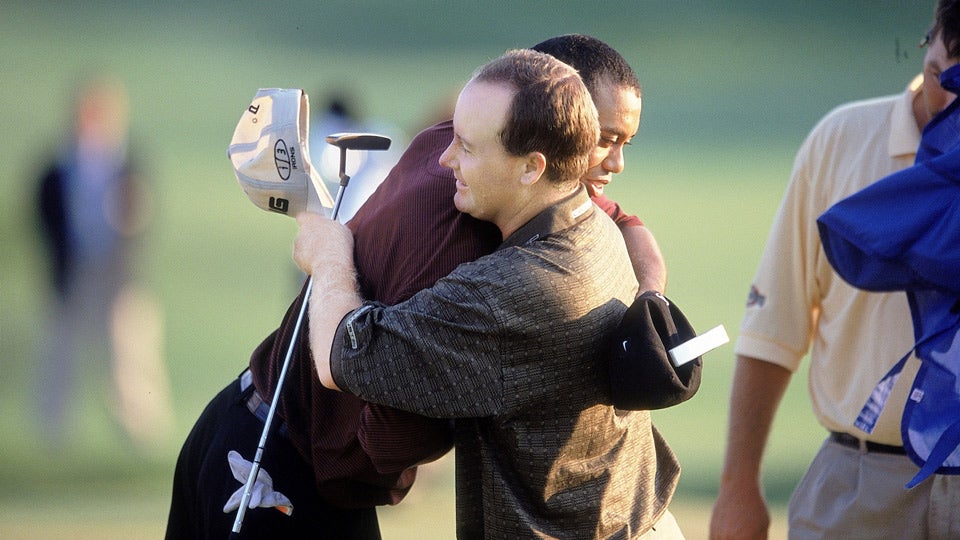
Wilder still, Tiger’s greatest-ever duel was with… a 31-year-old journeyman named Bob May? May was a relative unknown, although he’d been a superstar in California junior golf when a young Tiger was growing up. Subsequent back problems meant that May had all but vanished within a few years of the Valhalla thriller, but he was a rival in the skills department. A back-nine 31 at Valhalla helped him finished 72 holes at 18 under, a PGA record that Tiger tied moments later. May shot his third 66 in the final round.
“I think if you shoot three 66s in a major, you should win,” May said. “But you’re playing against the best player in the world, and he proved it wasn’t good enough.”
The PGA win was Tiger’s third in a row. He’d go on to make it four in a row the following spring at Augusta.
It almost wasn’t a playoff duel at all. Woods needed 15 putts over his final 12 holes, and he’d lost the lead early in the final round — it wasn’t until that first playoff hole and that theatrical birdie putt that he regained it. The key moment of the duel came at the 15th. Woods holed a tricky 15-footer to save par, and then May missed his four-foot birdie putt. If it had gone the other way, May would have cruised in with a three-stroke lead. Instead, his lead was only one. And Tiger, 24, quickly erased that with a wedge shot to four feet for birdie at the 17th.
So they went to the 72nd hole tied for the lead. Both players reached the par-5 green in two, but each had a long putt. May’s effort ended up 18 feet away. It didn’t look good. Tiger hit his putt to six feet, still not a gimme. May then dropped his momentous putt in a stunning instant, and Tiger followed by making his, too.
That exchange led to a three-hole playoff. Woods took the edge on the first extra hole with that famous putt. They got up and down for pars at the second hole, and at 18, Woods hit a greenside bunker shot to a foot for a tap-in birdie, and then watched as May missed a long eagle try.
“It was one memorable battle,” Woods said. “Birdie for birdie, shot for shot, we were going right at each other. I think it’s got to go down as one of the best duels in a major championship.”
It turned out to be the most dramatic shootout in Tiger’s career — and possibly the most memorable victory of a memorable career.— Gary Van Sickle
No. 4 – The 2001 Masters
There were plenty of nicknames for a Grand Slam that was or wasn’t a Grand Slam, depending on whether you were a golf traditionalist who lived by the calendar or simply a golf fan who marveled at four major championship wins in a row.
The losers in the naming derby included Phi Slamma Granda, Thai Slamma Granda, Fiscal-Year Slam, Major Sweep and, courtesy of legendary golf scribe Dan Jenkins, the Mulligan Slam (since Tiger needed a second try at the Masters to complete this Slam) and the Woods Wins Quartet, a bridge (and a pun) too far.
The phrase “Tiger Slam” eventually stuck, and it was a fitting way to describe the unthinkable. When Tiger Woods won the 2001 Masters, he completed an unparalleled run through golf’s greatest championships. For the next two months, all four of golf’s major trophies would sit on Tiger’s mantel.

Woods did what Jack Nicklaus and Ben Hogan and all the rest couldn’t. Only Bobby Jones had ever won a Grand Slam and his was the Opens — the U.S. and British — and the Amateurs — the U.S. and British. No one had ever won four professional majors in a row. Only Hogan and Nicklaus had won three straight, and Jack’s, by the way, were not in the same calendar year, either.
In 2001, it seemed as if Tiger’s winning streak might go on indefinitely. He had no real rival. The game’s other top players were Phil Mickelson, who still hadn’t won a major; David Duval, who still hadn’t won a major; and Vijay Singh, who put the green jacket on the Tiger Slam champion but didn’t have the skill on the greens to sustain any real challenge.
Duval finished second at this historic Masters, two shots behind Woods, whose winning score of 16 under par was only two strokes off the tournament record he had set in 1997. Mickelson was three back.
Mickelson and Duval saw their hopes fade Sunday with costly errors at the par-3 16th. Duval flew it over the green and made bogey. Mickelson later said he pulled his 7-iron shot, but some observers thought he simply was unable or unwilling to go against his natural left-to-right shot shape and that ball spin was what caused his shot to stay up on the slope above the back-left pin location. A right-to-left shot, not in Phil’s repertoire, almost certainly would have spun down to the hole. Phil’s first putt raced past the cup and he three-putted for a bogey.
Woods birdied the 18th hole to cap a remarkable run and the Grand-Tiger-Mulligan Slam, whatever you wanted to call it.
“To win four in succession, that’s hard to believe,” Woods said. “On top of that, you’ve got to have some luck.”
It gave Tiger six major titles, tying Nick Faldo and Lee Trevino for 11th place on the all-time major championship list.
CBS announcer Jim Nantz made the call as Tiger finished, and he kept the terminology bland: “There it is! As good as it gets! Tiger has his Slam!”
At the Masters award ceremony, Augusta National chairman Hootie Johnson summed it up best while, like Nantz, deftly avoiding any naming controversy. “We have witnessed the greatest golfing feat of our time,” Johnson said.
That was one thing we could all agree on.— Gary Van Sickle
No. 3 – The 2008 U.S. Open
In my office at home I have a photograph taken milliseconds after Tiger Woods holed his do-or-die putt on the 72nd hole of the 2008 U.S. Open. Woods’ lusty double fist-pump celebration was instantly iconic, but my eyes always go to the throng circling the final green at Torrey Pines. Peeking over the shoulder of a gaggle of photographers is yours truly. Everyone in the photo is cheering but I’m laughing maniacally. The reasons are both idiosyncratic and universal. I was laughing because what else could you do in the face of such genius? Bumpy green, broken leg, insane amount of pressure…and Tiger brushed it in like a practice round gimme. It was so absurd, giggling seemed the only logical response. But it was also a mirthless laugh at my own misfortune. Allow me to explain.
That week in June 2008 happened to be the very first time SI was operating under a new, compressed production schedule. Prior to that, we sent the magazine to the printers late Monday nights. But that Monday at the Open we were operating under a tighter deadline: the mag had to be buttoned-up by 1 p.m. California time, which was roughly when Woods and Rocco Mediate would be finishing their 18-hole playoff. I was laughing because I knew I was utterly screwed.

That Sunday night, at my hotel room in San Diego, I wrote two 3,000 word stories. One was celebrating Woods for the grittiest victory of his career. (A few spots were left open to insert details of the playoff.) I finished that story around 2 a.m., had a celebratory room service slice of cake, and then wrote until sunrise the account of a heroic Mediate producing an upset for the ages. There was plenty of fodder for each story. The details of Woods’ double stress fracture in his left tibia wouldn’t be made public until later, but he was clearly hurting. In his diminished state he produced some wildly uneven golf, including four double bogeys.
But he also torched his back nine on Friday in 30 strokes, and Woods’ final flourish on Saturday remains legendary. He had played the first 12 holes in 3 over par and looked to be running out of Band-Aids, but on the 13th hole he buried a big-breaking, downhill 65-foot eagle putt. On the 17th hole he jarred a chip for birdie and then at 18, after two perfect shots, faced another eagle putt. Back then, Woods had a metaphysical mastery of the moment, a singular ability to seize an opportunity that his third-round playing partner Robert Karlsson described as “freakish.” Watching Woods stalk his 30-foot putt, Karlsson, like everybody else, considered the outcome preordained. “No doubt,” said Karlsson. “That putt was just in.” And so it was.
At that point, Woods was 13-for-13 closing out 54-hole leads at major championships, but he was shaky on Sunday, double-bogeying the first hole again (his injury made it impossible to warm up properly) and later bogeying 13 and 15 to cough up the lead. It took his spectacular birdie putt on the 72nd hole to force the playoff and set up my misery.
After my all-nighter, I straggled to the course to monitor the playoff from the press room, tweaking each story continuously depending on who was doing what. When Mediate bogeyed 9 and 10 in the playoff he was down by three strokes and I was ready to delete the file about his hypothetical victory. But he birdied 13, 14 and 15 to surge into the lead and in my sleepless state I could barely deal with this reversal of fortune. Naturally, Woods birdied 18 again to extend the playoff — are you freakin’ kidding me?! — and when Mediate bogeyed the 19th hole Tiger had his myth-making victory.
In a scrum before his formal press conference I asked Tiger how this victory compared to all the others. “I think this one is the best,” Woods said, “just because of all the things I had to deal with.” I phoned that in to the New York office and the printers started rolling. Two days later I pulled the issue out of my mailbox, with Woods on the cover.
I just reread both stories. The Mediate narrative is groan-inducing good fun, a time capsule from an alternate universe. One line in the Woods piece really struck me: “With his 14 career majors Woods has crept ever closer to Nicklaus’s epic total of 18, and it is mind-boggling to think that at 32 he is potentially one great calendar year away from attaining the unattainable.”
How could we possibly have known then that we were witnessing the zenith? Woods lost the rest of 2008 and the first two months of ’09 to surgery and physical therapy. He played well upon his return but was not quite the same, missing opportunities to win at the Masters and U.S. Open, missing the cut at the British and then getting Y.E. Yang’d at the ’09 PGA Championship. Three months after that epic upset, Woods’s life was torn asunder in the biggest sex scandal of the Internet age. So Torrey Pines will always be peak-Tiger, the ultimate example of his scoring gifts and iron will. No matter how much it inconvenienced certain sportswriters, we were all lucky to witness it.— Alan Shipnuck
No. 2 – The 2000 U.S. Open
“It’s not a fair fight.”
Rarely has one sentence so perfectly encapsulated a golf tournament, but that was Roger Maltbie’s oft-repeated assessment of Tiger Woods’s landscape-altering blowout at the 2000 U.S. Open, the centerpiece of the greatest season in golf history. But it’s worth noting here that Woods’s victory at Pebble Beach was not quite as inevitable as it now seems.
Tiger had won his second major championship at the 1999 PGA Championship, two-and-a-half long seasons after his breakthrough at the Masters. In the interim he had torn apart his swing, leading to a tighter, shorter and more repeatable action. In Woods’s first seven events of 2000 he had three wins and three runner-ups, but at the Masters he laid an egg: an opening 75 during which he hit two balls into the water. That doomed him to fifth place and was of a piece with the 1999 PGA, where he almost blew a 5- stroke lead on the back nine on Sunday.
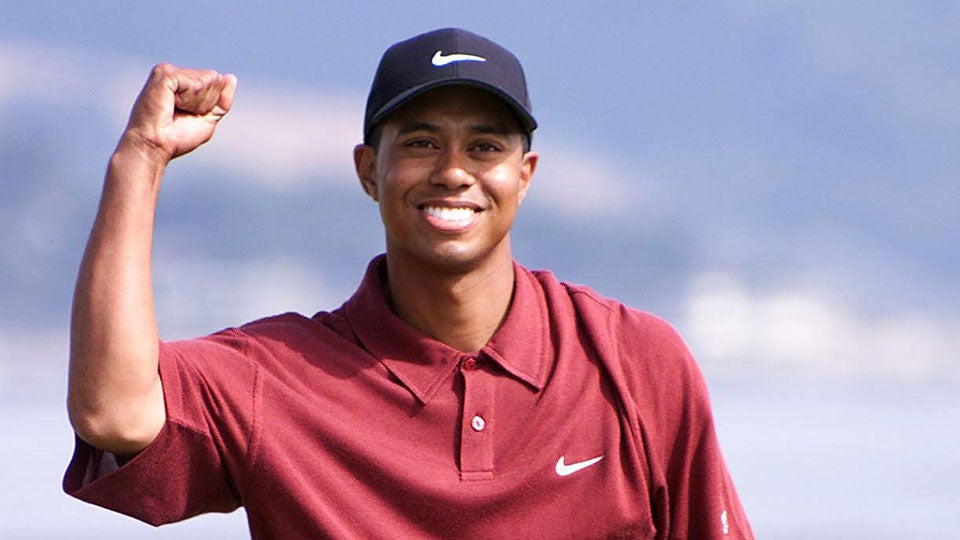
Woods’s 65 on Thursday at Pebble was a bold opening statement but it didn’t give him the separation you’d expect at a U.S. Open. In perfect scoring conditions, Miguel Angel Jimenez posted a 66, John Huston a 67 and Hale Irwin, Loren Roberts and Bobby Clampett came home in 68. The second round was much breezier and the USGA offered a sterner setup, leading to widespread bloodshed. The above players averaged 76 on Friday, while Woods brawled his way to a 69 that gave him a commanding six-stroke lead. It was during the second round that Woods, facing a horrendous lie in the rough, smashed a seven-iron over a tree, around the ocean and up a mountain onto the 6th green to setup an eagle putt. It was that display of power, guts and precision that led Maltbie to all but concede the tournament to Woods. He was unrelenting on the weekend, including a bogey-free 67 on Sunday that led to a record 15-stroke victory. The Tiger Slam had begun.— Alan Shipnuck
No. 1 – The 1997 Masters
The 1997 Masters was years in the making. Tiger Woods had won the USGA junior national title in 1991, ’92 and ’93. He won the U.S. amateur in ’94, ’95 and ’96. In ’97, at Augusta, he would be playing in his first major as a professional. He was already a proven winner on Tour. His amateur career in the four majors, amassed when he was still a Stanford student, no longer meant anything.
The ’95 Masters was an all-timer, Ben Crenshaw winning days after burying his teacher, Harvey Penick. The iconic photographs of Crenshaw being consoled by his tall, slender caddie, Carl Jackson, moved millions of people, way beyond the borders of golf. In ’96, Greg Norman had a six-shot lead going into Masters Sunday, and lost to his playing partner, Nick Faldo, by five. It was like watching a funeral, gripping but depressing. The hug the two men shared, despite nothing but a vague animosity between them, again brought millions to the game who otherwise would not have been paying attention.
And now it was ’97.
It was springtime in Augusta, America and the world. The Masters had never been bigger. Tiger had never been bigger. You could easily make the case that golf had never been bigger. Not under Bob Jones, who invented the USGA (pretty much) and Augusta National. Not under Arnold. Not under Jack. The moment was just there.
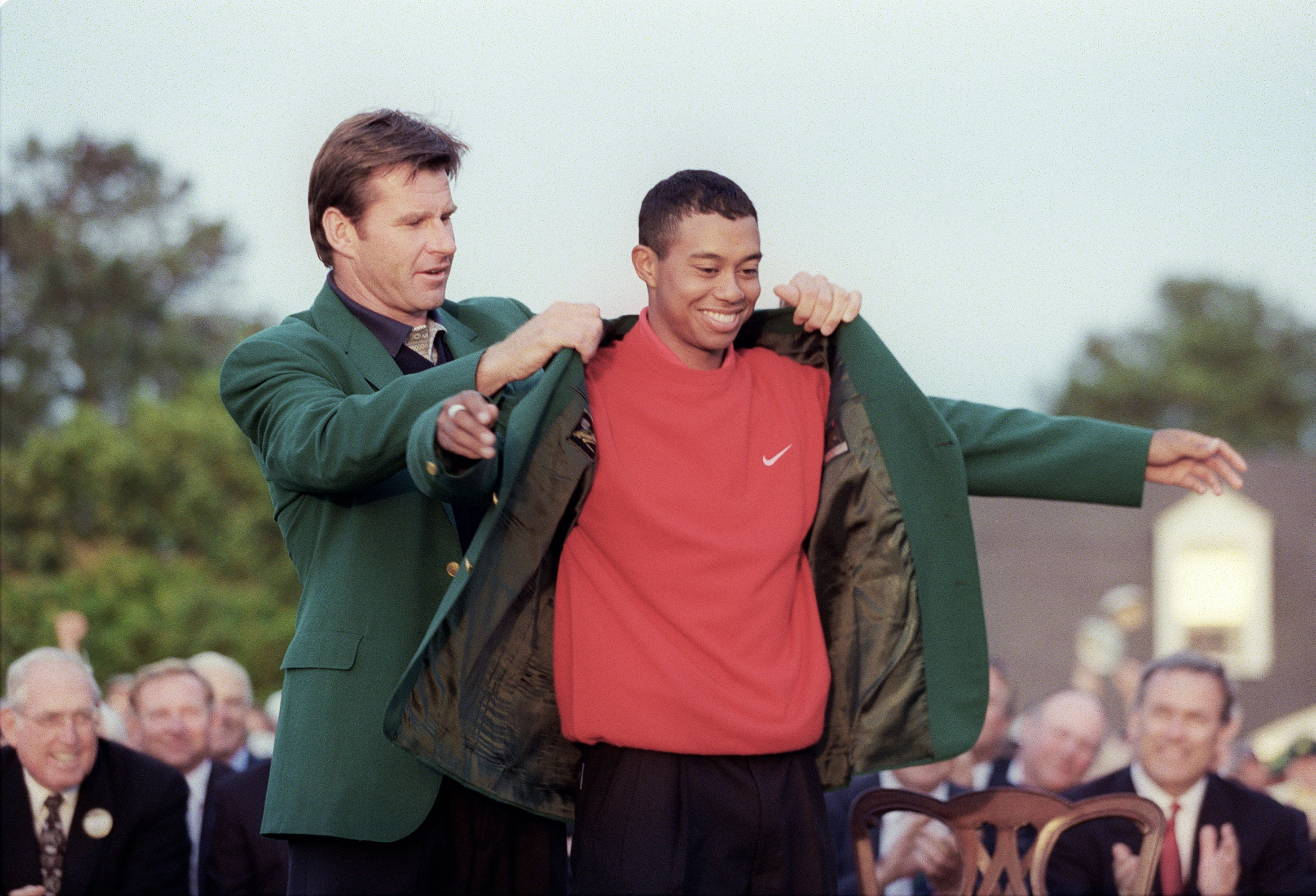
And the kid went out in 40. You wondered if he would make the cut.
You know what happened next. He played the back nine in 30 shots, four under par. Yes, we know the back-nine at Augusta National is a par-36. On the card. But Woods, playing a short-shafted steel driver with a little tiny head, was hitting the drop-dead beautiful baby-draw tee shots that were in the air forever. He played 13 and 15, the two iconic back-nine three- shotters, not as par-5s, but as short par-4s. After his opening 70 there were only three players ahead of him.
Unfairly, we — millions of us, who love golf but were ashamed of its elitist reputation — assigned a job to Woods for which he never volunteered. This bright (Stanford), telegenic (what a smile!) working-class (son of an Army officer) black (Cablinasian, if you must) kid (all of 21) was going to take the game, our game, places it had never been before. All he had to do was become the youngest person ever to win the Masters.
By Saturday night, that was a foregone conclusion. Ben Crenshaw — a drinker, a smoker, a Texan, an artist, as old-school as a June day is long — stood with the writers (writers!) and talked about a new day coming in. The Tiger Era! He was not forlorn. Not at all. He had had his day in the sun, no sunblock, but now Michael Jordan was moving in and the game would no longer need, and maybe even have room for, Pistol Pete Maravich. This is not sportswriter hyperbole. No, sir. Colin Montgomerie, a genius (in case you didn’t know), was spelling it all out on that Saturday night. “All I have to say is one brief comment,” Montgomerie said. He had played the third round with Woods. “There is no chance. We’re all human beings here. There’s no chance humanly possible that Tiger is going to lose this tournament. No way.” Why, the great Scot was asked. The Norman collapse was only a year old. “This is very different,” Montgomerie said. “Faldo’s not lying second, for a start. And Greg Norman’s not Tiger Woods.”
Greg Norman was a borderline transformational figure in the game. The face of golf, in the years after World War II, went from Ben Hogan to Arnold Palmer to Jack Nicklaus to Tom Watson to Greg Norman. But Montgomerie was saying what we were all about to learn: Norman’s impact was nothing compared to what Tiger Woods was about to do.
Masters Sunday ’95 pulled on your heartstrings. Masters Sunday ’96 ripped your heart. Masters Sunday ’97 expanded your noting of the possible. The kid won by 12 and he and the old man shared a hug that was seen around the world.
Right about then, anything and everything seemed possible. Maybe it was too good to be true. Maybe we were expecting too much. But, man alive was it exciting. He was so skinny, and his sweater, with the arms pushed up, was so red. — Michael Bamberger


